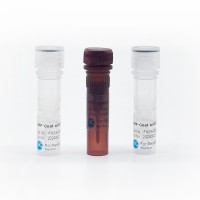PCR of Gene Rearrangements for the Detection of Minimal Residual Disease in Childhood ALL
互联网
|
Locus |
No b |
Primer sense (ref) |
No b |
Primer antisense (ref) |
[Mg2+ ] |
Size, bp |
+B |
+T- |
|---|---|---|---|---|---|---|---|---|
|
IgH FR3 |
1 |
5′-ACACGGC(C/T)(G/C)TGTATTACTGT-3′ (2) |
3 |
5′-GTGACCAGGGT(C/T)C C(C/T)TGGCCCCAG-3′ (2) |
1.5–30 |
65–155 |
75% |
8% |
|
4 |
5′-AACTGCAGAGGAGACGGTGACC-3′ (3) |
15–30 |
80–170 |
|||||
|
2 |
5′-GACCAGGGT(C/T)C C(C/T)TGGCCCCAG-3′ e |
|||||||
|
Vδ2-Dδ3 |
5 |
5′-CTTGCACCATCAGAGAGAGA-3′ (2) |
7 |
5′-GTTTTTGTACAGGTCTCTGT-3′ |
10–30 |
100–150 |
45% |
4% |
|
8 |
5′-AGGGAAATGCACTTTTGCC-3′ (2) |
15–30 |
110–170 |
|||||
|
6 |
5′-TTTTGTACAGGTCTCTGT-3′ c |
|||||||
|
Vδ1-Jδ1 |
5′-GCCTTACAGCTAGAAGATTC-3′ |
5′-GTTCCTTTTCCAAAGATGAG-3′ |
15–30 |
80–150 |
5% |
25% |
||
|
VγI-Jγ1/2 d |
5′-TG(A/C)(C/T)TCTGG(A/G)GTCTATTACTGT-3′ |
5′-CGATACTTACCTGTGACAAC(C/A)AG-3′ |
30 |
80–160 |
45% |
90% d |
||
|
VγII-Jγ-1/2 d |
5′-AAACAGGACATAGCTACCTACT-3′ |
5′-CGATACTTACCTGTGACAAACC/AAG-3′ |
30 |
80–160 |
45% |
90% d |
||
|
Lead Vγ2-anti Vγ2 |
5′-GTCATGTCAGCCATTGAGTT-3′ |
5′-TCTCTCTCTGATGGTGCAAG-3′ |
15 |
220 |
control |
control |









